Baler Knowledgebase / FAQ
The baler knowledge base considered as baling machine dictionary, provides our world wide customers very convenient database for answers and information sharing about hydraulic baling press machines especially waste recycling baler and other related waste compactors and recycling industry information. Sinobaler is here ready to service you through our yearly accumulated technical experience and huge internal database.
Feeding materials into a baler can be done in various ways depending on the type of materials, the equipment involved, and the setup of the baling system. Here’s a breakdown of some common feeding methods:
1.Excavator:
- Used for: Large, bulkier materials like scrap metal, wood, or other heavy materials.
- How it works: An excavator with a bucket or grapple is used to load materials into the hopper or feed opening of the baler. The excavator can precisely place materials into the feeding area.
- Advantages: Ideal for large-scale operations, especially when materials are heavy or difficult to move manually.
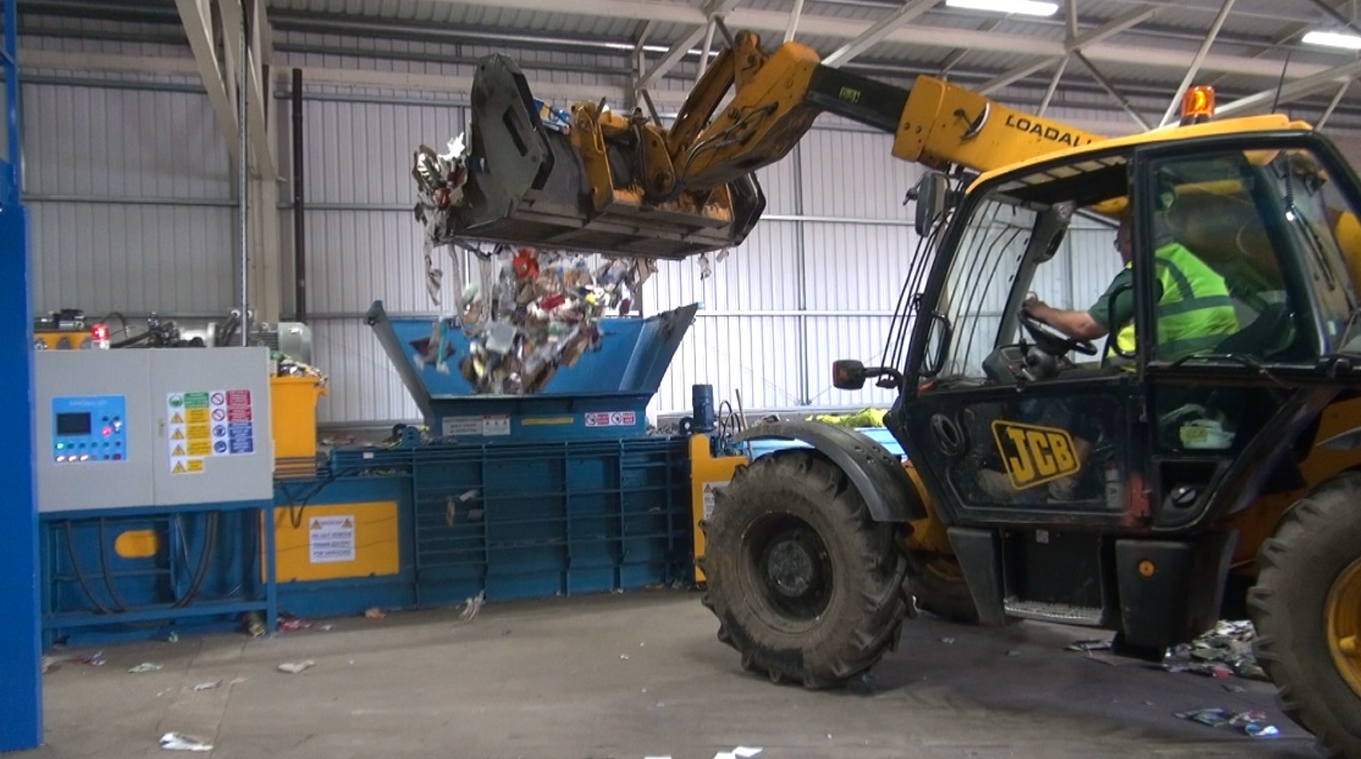
2. Air Cyclone:
- Used for: Light, fluffy materials like paper, plastic, or other recyclables that need to be separated from dust and debris.
- How it works: An air cyclone system uses airflow to move lightweight materials into the baler. It can also help in separating light materials from heavy ones before they enter the baling chamber.
- Advantages: Great for automating the process and improving efficiency when dealing with fine materials or mixed waste.
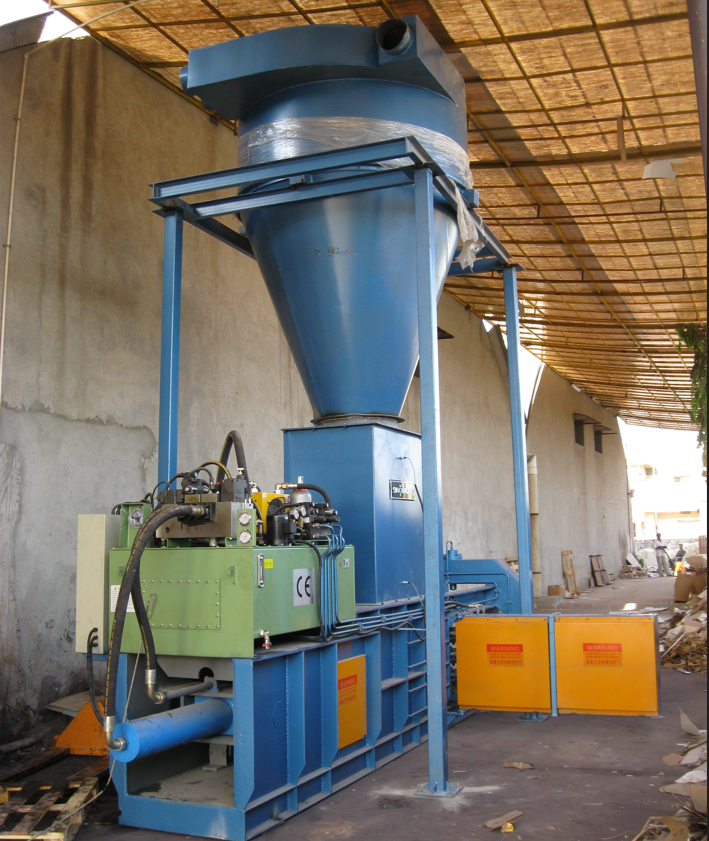
- Used for: Continuous feeding of materials like cardboard, plastics, textiles, or paper.
- How it works: Materials are loaded onto a conveyor belt, which moves the materials to the baler’s feed hopper. The conveyor can be configured to run automatically or manually, depending on the material flow and system design.
- Advantages: Ideal for continuous, high-volume feeding, especially in automated recycling plants or warehouses.
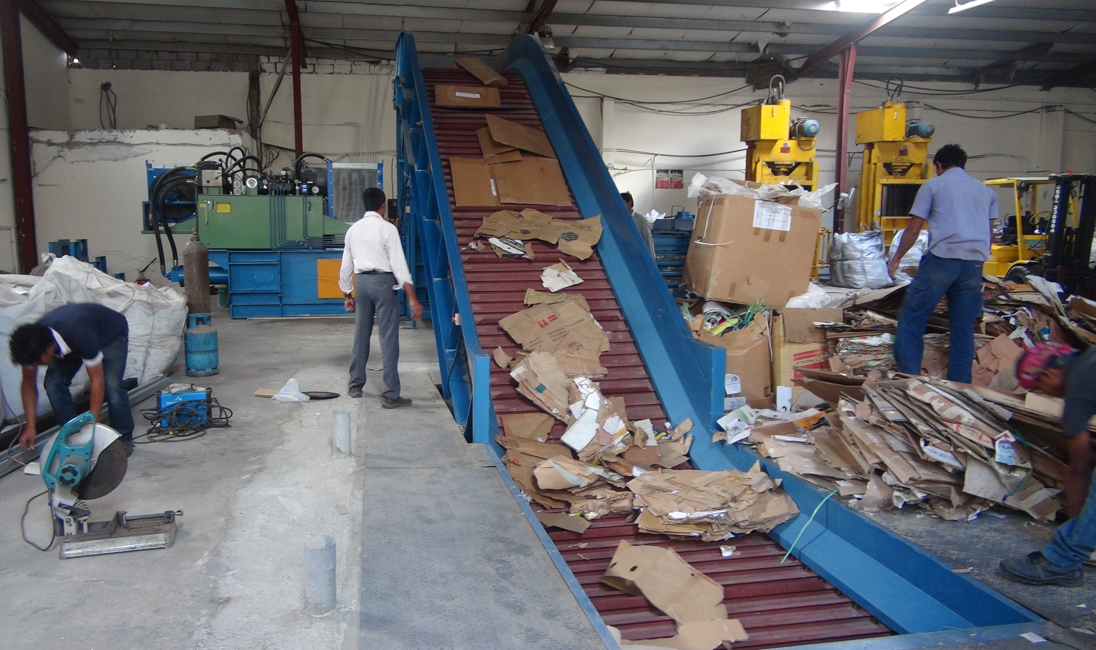
4. Dumper (Tippers):
- Used for: Materials in bins or containers, such as industrial waste, textiles, or recyclables.
- How it works: A dumper or tipper lifts a container of materials and dumps it directly into the baler’s feed hopper. This is often seen with bulk bins or compacted waste.
- Advantages: Simple and effective for large quantities of materials that are pre-loaded into containers. It reduces manual labor and speeds up the feeding process.


5. Other options:
- Manual Feeding: For smaller-scale operations or when dealing with materials that require sorting, workers might feed materials directly into the baler using forklifts or by hand.
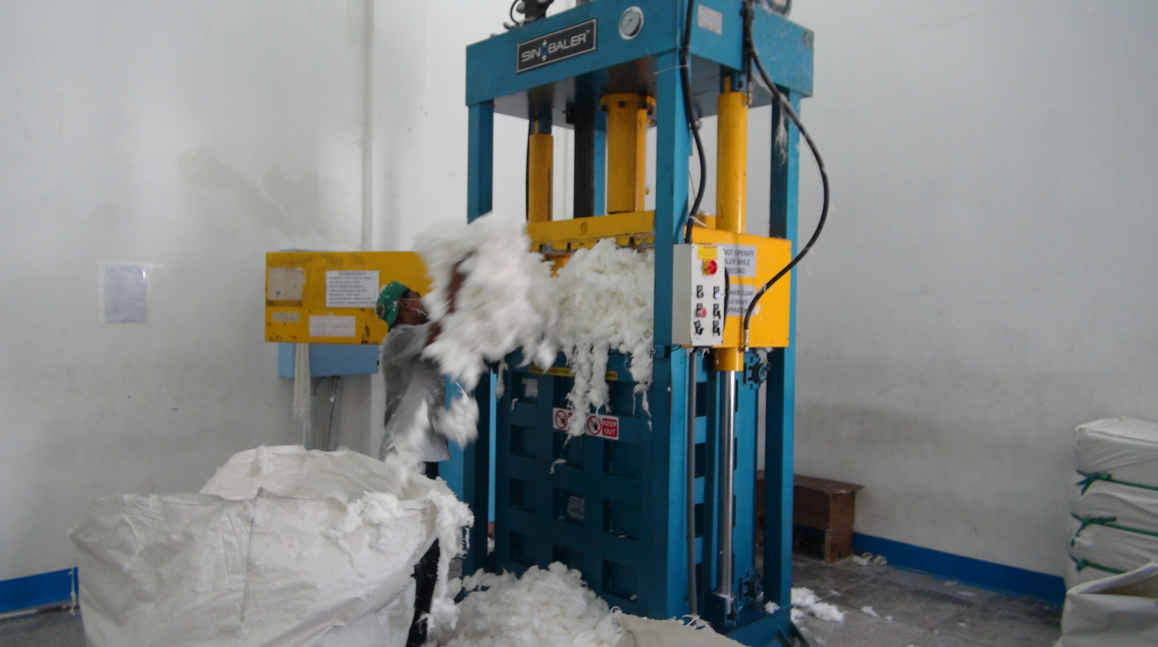
- Forklift: Can be used to lift and drop larger bales or materials into the baler’s feed area.
Each of these methods can be adapted based on the specific baling process, material type, and operational needs. For maximum efficiency, it's important to match the feeding method to the material characteristics and volume.
Why finding a suitable steel wire size is important to your machine as well as operations? In order to ensure smooth operation for your Automatic Horizontal Baler, you need to prepare suitable baling wires. A steel wire thinner than the suggested size will likely keep breaking during the tying process which will greatly affect efficiency. Following is the information of the suitable steel wire sizes for different model of SHBA2 series:
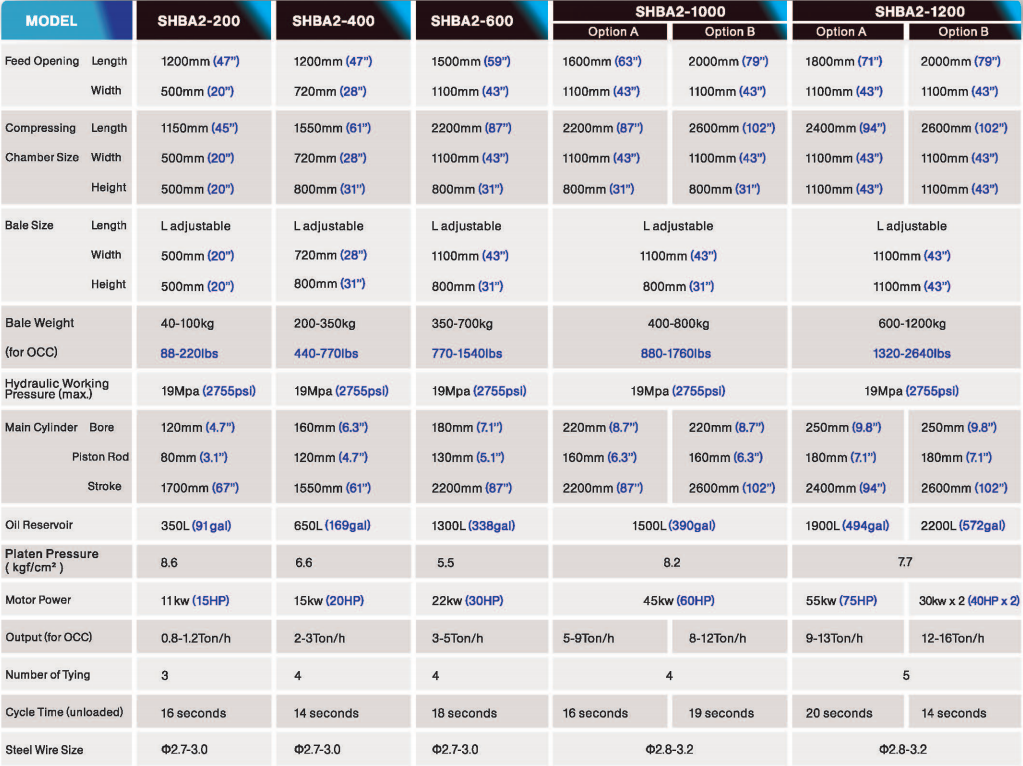
A wide variety of materials can be baled, depending on the baling equipment and intended recycling or disposal process. Here's a breakdown by category:
Paper & Cardboard
• Cardboard boxes (OCC)
• Office paper (white paper)
• Newspaper
• Paper cores and tubes
• Tissue and toilet paper waste
• Paper bags
• Mixed paper
Textiles
• Used clothes
• Rags and wipers
• Fabric scraps
• Carpets and rugs
• Shoes
• Non-woven textiles
Plastics
• PET bottles
• HDPE/LDPE containers
• Plastic films and shrink wraps
• Plastic drums and barrels
• Rigid/stiff plastic items
• Plastic bumpers
• Plastic purges and sprues
• PP woven bags
• Waste plastic sheets
Metals
• Steel cans
• Aluminum cans and scraps
• Iron scrap
• Copper tubes
• Cast iron scrap
• Turnings and borings (ferrous and non-ferrous)
• Nickel alloys
• Other non-ferrous metals
Biomass & Agricultural Waste
• Hay, straw, and alfalfa
• Husk (e.g., rice husk, peanut shell, coffee husk)
• Bagasse
• Seaweed
• Coco peat
• Cotton seed
• Compost
• Peat moss
Wood Waste
• Wood shavings and sawdust
• Wood chips
• Wood offcuts
Other Industrial & Special Waste
• Tires and rubber
• Bead wires from tires
• Paint tins and buckets
• Waste barrels
• Foam (PUR, etc.)
• Tipping foils
• Mixed waste (e.g., MSW or RDF input)
Browse our baler applications to discover the best machine for your needs.
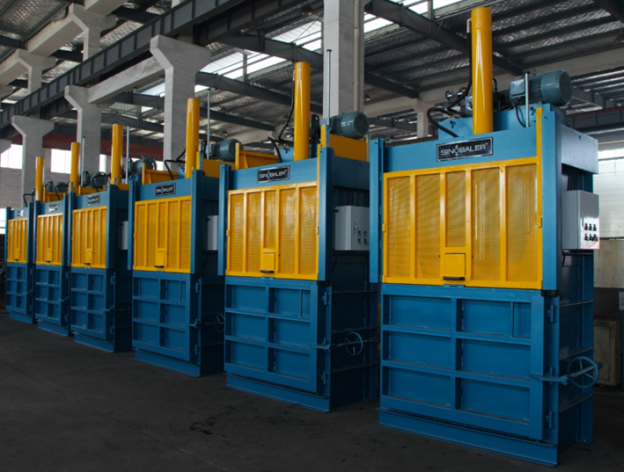
Mill Size Balers
1. Purpose
A quick installation and operation guide to teach you how to install and operate the machine correctly.
2. Tools Required
• Forklift: To lift and move the machine
• Three-phase power: Power for machine
• Hydraulic oil: For hydraulic system
• Fuel transfer pump: To pump hydraulic oil into oil tank
• Screwdriver: To connect power wires
3. Baler Structure
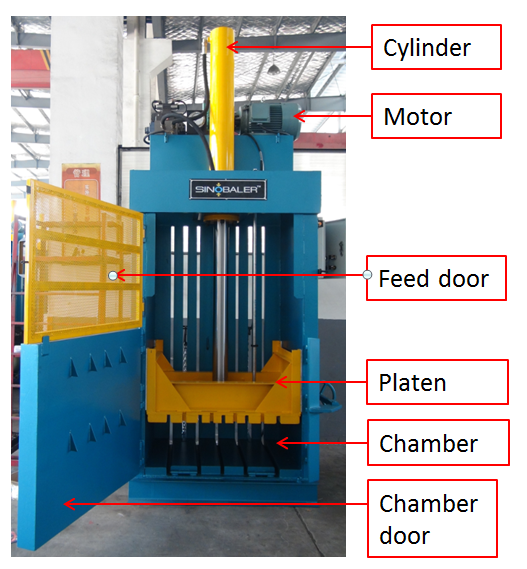
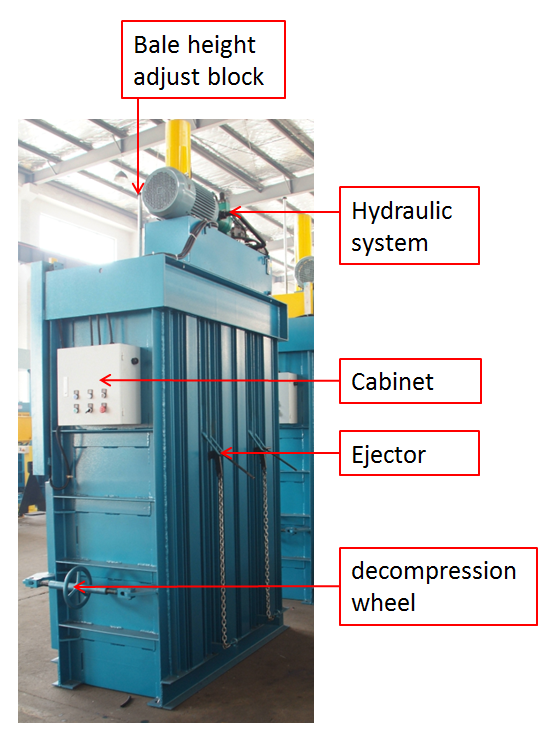
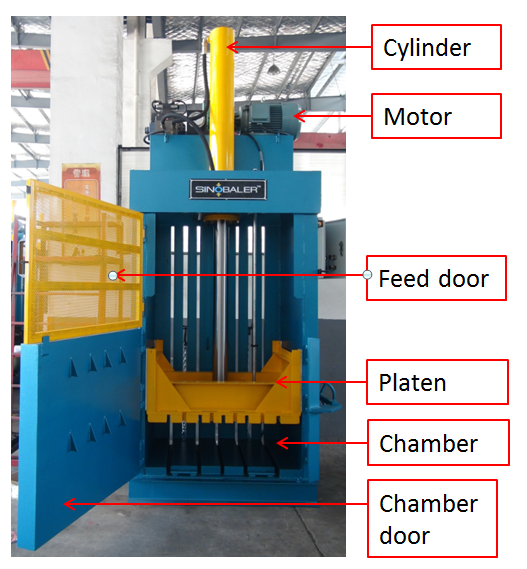
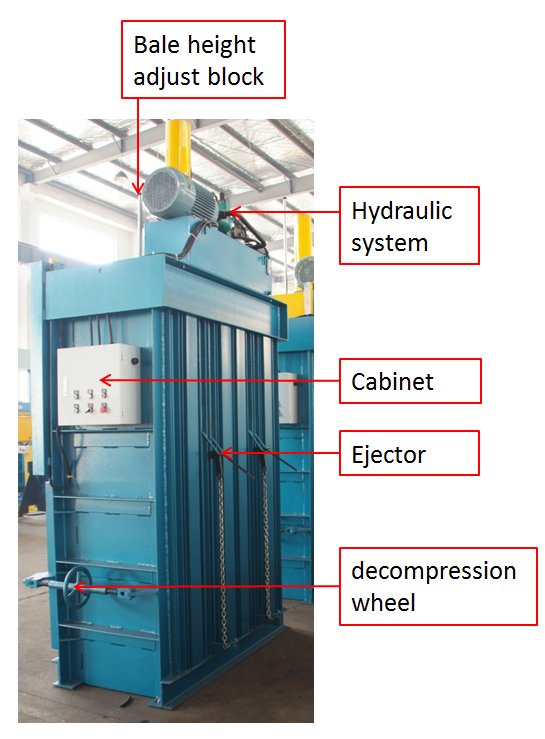
4. Inspecting the Machine
• Ensure the baler is placed on level ground.
• Check if the power switch and wires for loose connection or damages.
• Check the safety devices are complete and effective.
• Check if the hydraulic hose, joints are firmly fastened.
• Check for loose wires in cabinet, and/or machinery screws, tighten if necessary
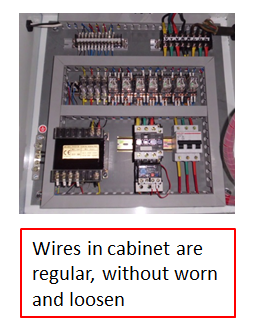
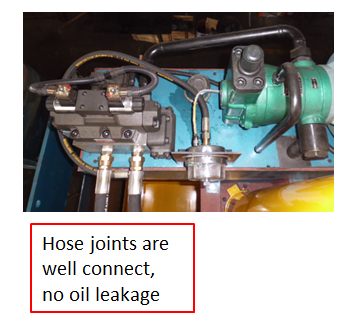
5. Installation and Operation
5.1 Connect the power supply
Make sure the voltage range meets the machine requirements.
Wires of electrical box => There are three live lines and one earth line.
The colors of wires comply with Chinese standard:
• Phase A – yellow
• Phase B – green
• Phase C – red
• Earth – yellow/green
Note: Connect the earth wire to the wiring terminal
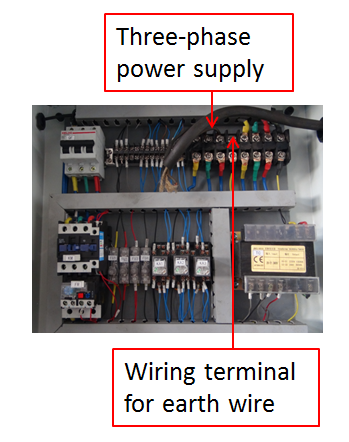
5.2 Fill Hydraulic Oil
Fill hydraulic oil through “Oil filler” until reaches “Best Oil Level”.
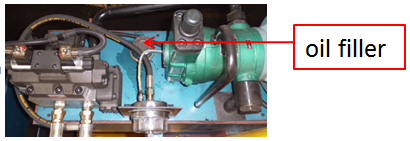
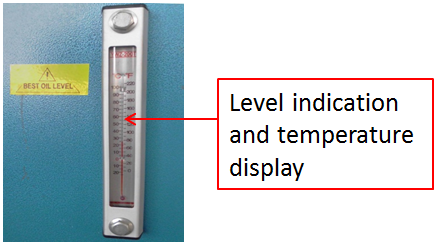
The requirements of the suitable hydraulic oil in different ambient temperature:

NOTE: If your machine is using Plunger Pump, it is important that clean hydraulic oil is in the pump before running the machine in order to lubricate the bearings and transmission system. Refer to “How to refill oil to Plunger Pump” if you need further information.
5.3 Turn on the main switch and observe for abnormality
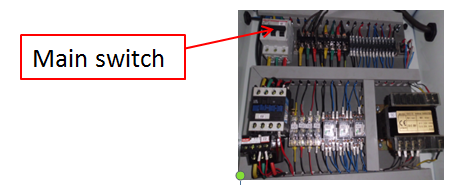
5.4 Start motor and then immediately stop
Observe the rotation from the motor fan. If the motor rotates in wrong direction (not as per the red arrow), inter-change any two phases of the three-phase power supply wires.
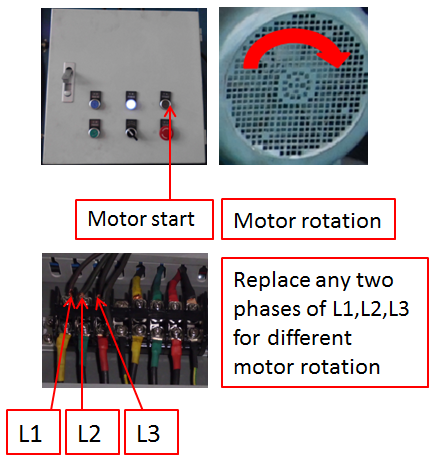
Start the motor and hydraulic pump to run it for about 1-3 min, then observe hydraulic pump, check if there is any abnormality like unusual noise or smell. If yes, switch off the machine immediately. Investigate the cause and eliminate abnormality. Proceed to restart motor once problem is rectified.
5.5 Check for Oil Leakage
If leakage is detected, rectify the cause or contact SINOBALER immediately.
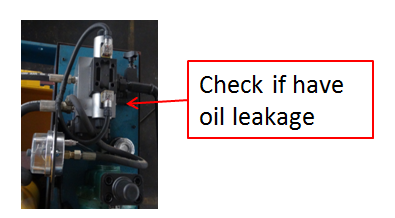
5.6 Check Oil Temperature
If the oil temperature is below 10 ° C, it is recommended to run the motor for a few minutes (do not load the machine with material or operate the platen at this point).
Begin to operate the machine once the oil temperature is above 10 ° C.
5.7 Test Running (without Material)
Control Panel
• Back (a): Move ram upwards
• Power Indicator Light (b): Light will be on when power is on
• Start (c): Start the motor
• Press (d): Move ram downwards
• Switch (e): Select “Auto” mode and “Manual” mode (see picture below)
• Stop (f): Stops the machine once pressed. To resume operation, just rotate the button clockwise as per the direction of arrow to reset.
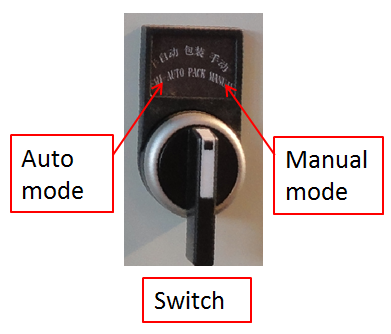
** Go to Control Panel and switch to “Manual” mode **
• Close the chamber door and feeding door, turn on the main switch and start the motor.
• Press “PRESS” button and hold, observe if the platen moves downwards steadily, no jam or abnormal sound.
• Press “BACK” button and hold, observe if the platen moves upwards steadily back to home position.
• Press “STOP” (red) button and check whether machine shuts down / motor stops (after that, turn it clockwise to reset the stop button).
Suggest to test run the above steps 2-4 times under “Manual” mode.
** Go to Control Panel and switch to “Auto” mode **
• Close the chamber door and feeding door, turn on the main switch and start the motor.
• Press “PRESS” button (just press once, no need to hold), platen will move downwards automatically.
• When the ram move downwards and trigger the bale height sensor, it will move upwards automatically.
Suggest to test run the above steps 2-4 times under “Auto” mode.
5.8 Trial Production
• According to auto mode test running steps, feed material into chamber from feeding door until full and begin baling cycle by pressing the “PRESS” button. Repeat step again.
• Platen will stop when achieved the pre-set bale height. Bale height is adjustable by moving the “Bale Height Adjust Block” as per picture below.
• Once the platen stops and not returning to home position, open the chamber door by turning the decompression wheel, and proceed to strap the bale.
• Hang the ejector chains on platen at the back of machine.
• Press “BACK” to move the platen upwards and bale will be ejected out in this process. DO NOT stand in front of baler during ejecting.
• Repeat the next baling cycle. The bale ejector chains will release automatically when the platen press down for the next compressing cycle.
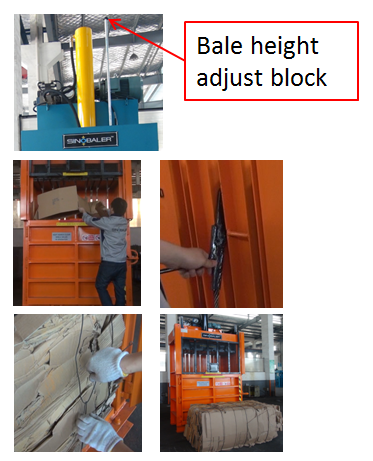
Caution:
• During test running, inspect the machine for any abnormality (i.e. abnormal noise, leakage, etc.). Check the machine again after test run. If all normal, you can start mass production.
• DO NOT remove or override any safety guards or switches to operate the machine.
• Do not start and stop motor too frequently as it may burn the motor.
6. End of Operations
• Move platen upwards to home position
• Reset the ejector chains
• Clear away any residual material in chamber and close chamber door
• Close feeding door
• Turn off motor by pressing the Stop button
• Switch off main power
• Clean the machine and its surrounding
• Arrange tools neatly, and clean-up site / work area
It is important that clean hydraulic oil is in the pump before running the machine in order to lubricate the bearings and transmission system.
Therefore, do check the pump once you filled up the oil tank, steps as follow:
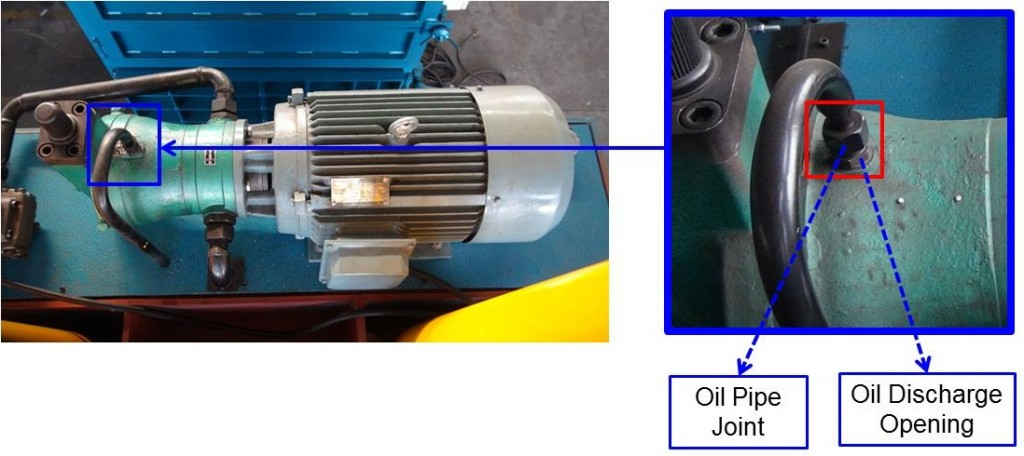
• Unscrew and remove the oil pipe joint using a wrench.
• Once joint and oil pipe is removed, you can see the oil discharge opening. Fill hydraulic oil through the opening until it is full to the brim. (If there is air in the pump, it will create loud noise when you run it, which might cause damages)
• Reconnect the oil pipe and ensure the joint is tightly fastened.
Upon releasing your baling machine from our factory, we will indicate the required amount of hydraulic oil based on your working condition and environment temperature, and reflect it as Best Oil Level for your baler.
You can easily refer to the “Best Oil Level” stickers as a gauge when you are filling up the oil tank and conduct regular checks on oil level (as seen on picture, slight variation above or below the level line is acceptable).
Taking into consideration that actual operation hours and conditions may varies from time to time, regular checks on oil temperature and level is strongly recommended.
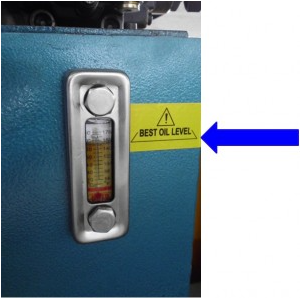
Best Oil Level sticker
Increasing or decreasing the compressing pressure will directly affect the density of your bale. Please follow the steps below to learn how to adjust compressing pressure on your baler. Remember to refer to the safety working pressure stated on your Operator Instruction Manual to ensure you don’t go above the limit.
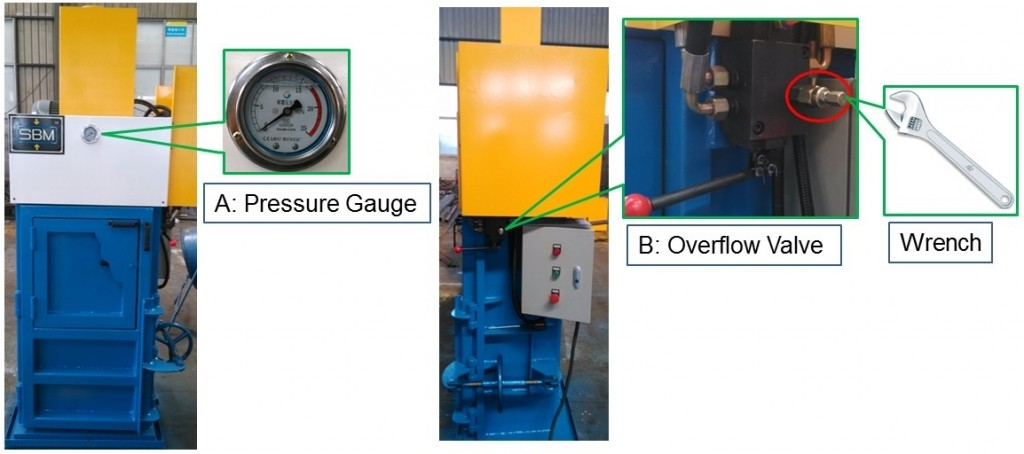
Pressure adjustment steps for Mini Baler:
1. Turn on the power and start the motor.
2. Use a wrench to loosen the nut on overflow valve (see B). Adjust overflow valve by using a wrench to turn clockwise (circled in red) during baling. You will see the pointer of pressure gauge (see A) increase during the process. Turning the valve anti-clockwise, you will see a decrease of pressure.
NOTE:
– Adjust the valve slowly to achieve higher pressure, check the pressure gauge at all time so as to not increase too much at one time.
– The recommended pressure has already been set at our factory before delivery. Therefore, do not make any adjustment to pressure unless it is necessary.
– Do remember to use the wrench to tighten the nut when done.
Increasing or decreasing the compressing pressure will directly affect the density of your bale. Please follow the steps below to learn how to adjust compressing pressure on your baler. Remember to refer to the safety working pressure stated on your Operator Instruction Manual to ensure you don’t go above the limit.
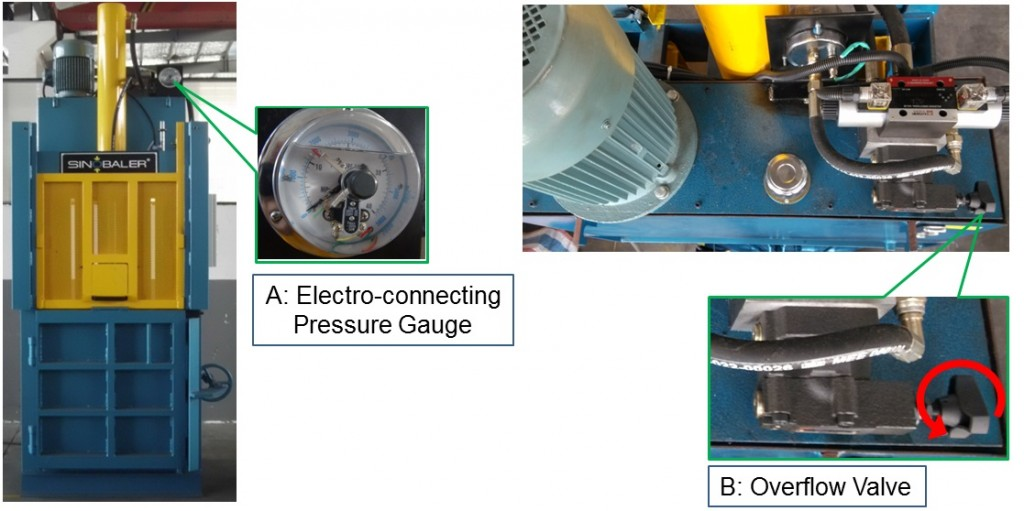
Pressure adjustment steps for Mill Size Baler:
1. Start the motor by pressing the “START” button on control panel.
2. Adjust overflow valve (see B) by turning knob clockwise (as per the red arrow) during baling, you will see the pointer of electro-connecting pressure gauge (see A) increase during the process. Turning the knob anti-clockwise, you will see a decrease of pressure.
NOTE:
– Adjust the valve slowly to achieve higher pressure, check the pressure gauge at all time so as to not increase too much at one time.
– The recommended pressure has already been set at our factory before delivery. Therefore, do not make any adjustment to pressure unless it is necessary.
Increasing or decreasing the compressing pressure will directly affect the density of your bale. Please follow the steps below to learn how to adjust compressing pressure on your baling machine. We strongly advise you to refer to the safety working pressure stated on your Operator Instruction Manual to ensure you don’t go above the limit.

Pressure adjustment steps for Heavy Duty Horizontal Bagging Baler:
1. Turn on the power and start the motor.
2. Adjust overflow valve (2) by turning the plastic knob clockwise (as per the red arrow) during baling. Observe the pressure gauge at the same time to monitor the increase of pressure. For your info, turning the knob anti-clockwise will decrease the pressure.
3. However, if the pressure did not go up after adjusting overflow valve (2), please go to overflow valve (1) and turn the knob clockwise as per the red arrow. Observe the pressure gauge at the same time to monitor the increase of pressure.
NOTE:
– Adjust the valve slowly to achieve higher pressure, check the pressure gauge at all time so as to not increase too much at one time.
– The recommended pressure has already been set at our factory before delivery. Therefore, do not make any adjustment to pressure unless it is necessary.
Increasing or decreasing the compressing pressure will directly affect the density of your bale. Please follow the steps below to learn how to adjust compressing pressure on your baler. Remember to refer to the safety working pressure stated on your Operator Instruction Manual to ensure you don’t go above the limit.
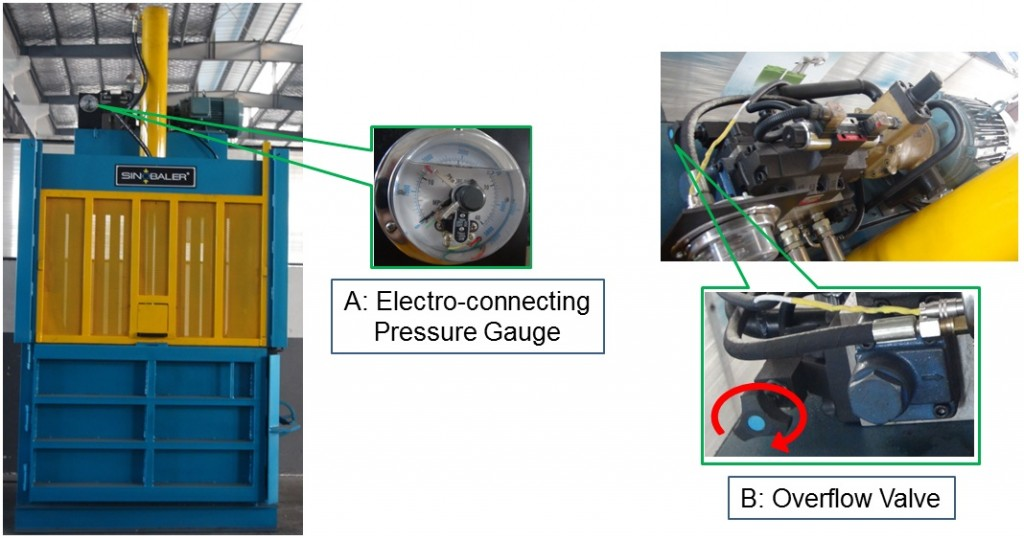
Pressure adjustment steps for Long Stroke Baler:
1. Turn on the power and start the motor.
2. Adjust overflow valve (see B) by turning knob clockwise as per the red arrow during baling, you will see the pointer of electro-connecting pressure gauge (see A) increase during the process. Turning the knob anti-clockwise, you will see a decrease of pressure.
NOTE:
– Adjust the valve slowly to achieve higher pressure, check the pressure gauge at all time so as to not increase too much at one time.
– The recommended pressure has already been set at our factory before delivery. Therefore, do not make any adjustment to pressure unless it is necessary.
Ask us!
Don’t see the question you are looking for? Ask us!
PRIVACY POLICY
We collect information from you when you fill out an inquiry or contact form. When submitting the form on our site, you may be asked to enter your name and contact details such as: e-mail address, mailing address and/or phone number, etc. Alternatively, you can choose not to complete our forms and visit our site anonymously. Any of the information we collect from you may be used to help us to better respond to your individual needs, and/or enable us to more effectively respond to your customer service requests and support needs. The email address you provided may also be used to send you information and updates pertaining to your inquiry and/or order, in addition to receiving occasional company news, updates, related product or service information, etc. SINOBALER does not sell, trade, or otherwise transfer to outside parties your personally identifiable information. This does not include trusted third parties who assist us in operating our website, conducting our business, or servicing you, so long as those parties agree to keep this information confidential. We may also release your information when we believe release is appropriate to comply with the law, enforce our site policies, or protect ours or others rights, property, or safety.
By using our site, you consent to our online privacy policy. If we decide to change our privacy policy, we will post those changes on this page. If you have any questions or concerns regarding our privacy policy, please e-mail info@sinobaler.com or mail your question to us at 1206 Yinzhou Shanghui Nan Lou, 1299 Yinxian Avenue, Yinzhou District, Ningbo 315192, P.R. China.
EXTERNAL LINKS & DISCLAIMER
Our web site has links to many other organizations with their permission. Upon leaving the SINOBALER web site, you are subject to the privacy policy of the new site which are not under our control. SINOBALER is not responsible for the content of any linked site or any link contained in a linked site. These links are provided to you as a service for you to better understand the different business relationships that SINOBALER has established, and/or to point the reader to other possible relevant resources.






























